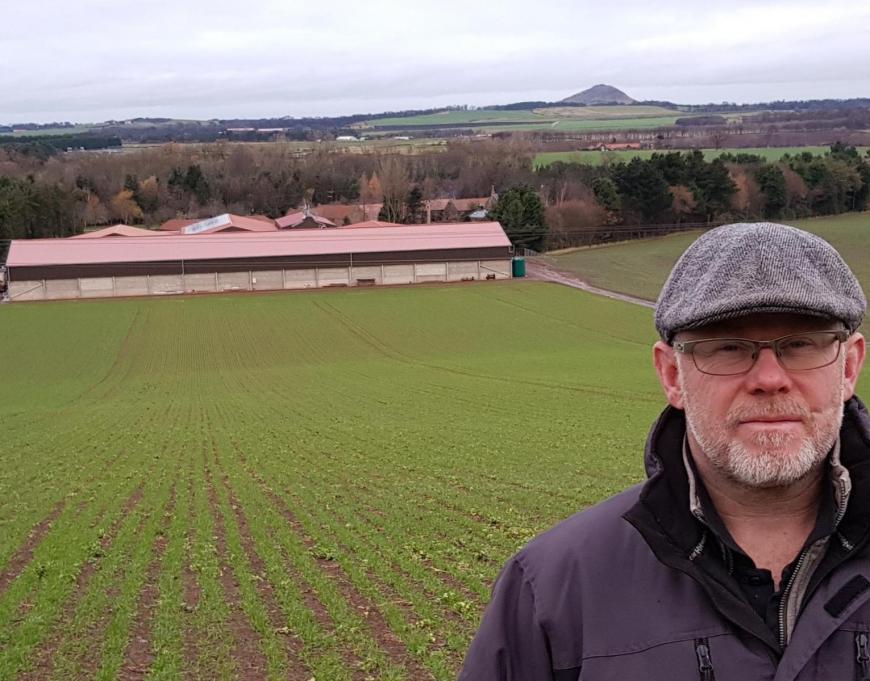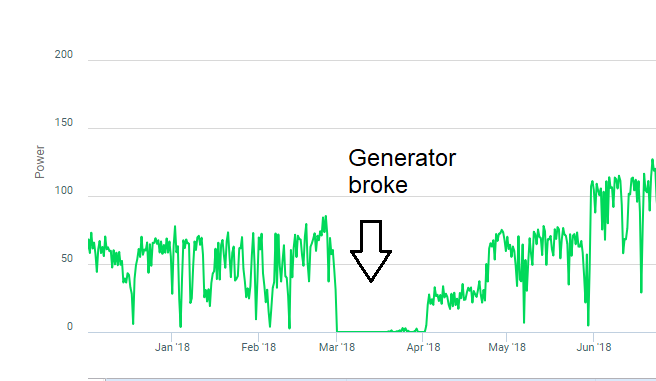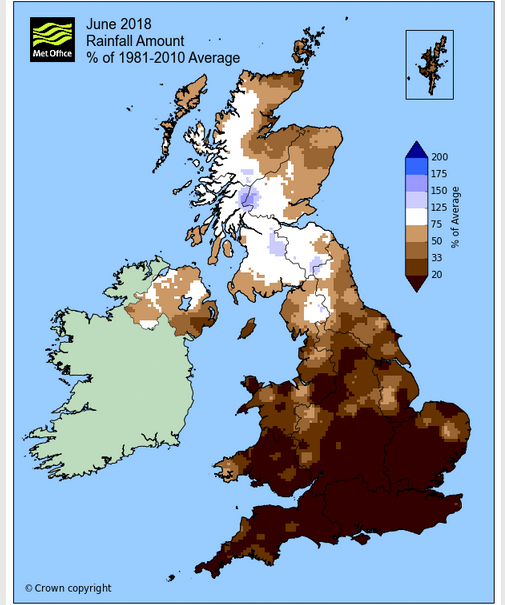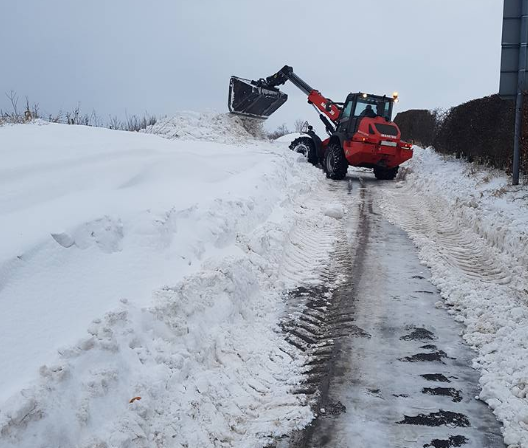
2018 was quite a year weather-wise. The two major events brought up completely different extremes, one of severe winter cold and snow, the other of summer heat and drought. These affected people’s lives, work, schools, the health service, industry and tourism. However, farmers, especially those with livestock, can’t just lurk indoors, waiting for the worst of the cold weather to pass, or take it easy in the heat. Crops and animals are usually buffeted by our UK weather but 2018 was something else.
I spoke to farmer William Middlemass, whose family have owned an East Lothian farm for over 100 years. The 560-acre arable farm in SE Scotland has been worked by five generations and I asked him about local experiences during this most peculiar year.
Stop moaning about the weather. It’s a waste of energy. Plan for it.
William started by telling me that it is drummed into farmers not to bother complaining about the weather.
I’m sure that doesn’t stop it being a top topic of discussion as farming life wrestles on.

Like many others, the Middlemass farm has diversified over the years, arable fields being a small but simple part of the business. Planting in autumn 2017 did allow some protection from winter 2018, with crops of wheat, fava beans and oilseed rape. They have a wood chip processor and kiln dry logs, both of which see the highest demand when it is cold.
We also talked about other farmers with livestock and other crops and their issues in the extreme cold and then during the heatwave and drought. How the crops faired and the silage/hay trauma which drove prices sky high with possible future adaptations.
Snowdrift buried lambs made the news late Feb./early March. The snow from the Beast from the East wasn’t heavy or wet, it was light and quite dry in composition. With the stiff east wind which just kept on coming, the snow blew and blew. Only stopping at hedges and walls, often the very spots where the sheep has tried to shelter. East Lothian is divided by the A1 west to east and crisscrossed by lots of minor roads running north/south. These roads just filled in, feet deep and if cleared, then the drifts returned the next day.
The timing of the snow was terrible too. Lambing was well underway. Nine times out of ten the sheep would be okay, they would survive winter weather. There is no spare cash for hillside sheds. This time sheep suffocated, and lambs expired, dying of hypothermia. Piles of dead sheep. The bitter cold was well forecast, that is not disputed, there is just little farmers can do.
For sheltered pigs, poultry and cows the problem was drinking water. The pipes froze and the low temps prevented the auto feeding mechanisms from working, for 3 or 4 days and cows especially drink vast amounts of water. The watering then had to be done by hand as the water networks froze up. The farmers were already busy, this added extra strain and work. There are more dairy farms in the west of Scotland. The main problems with snow were for eastern counties, as in other parts of the UK, but it did reach through the Central Belt. If dairy farms get blocked in, the cows still need to be milked and that milk just gets poured down the drain.
Thinking back to previous snowy winters, one difference was that there weren’t too many buildings collapsing this time. In 2010/2011 the snow had been wetter and without the brisk winds, it built up and up. The sheer weight caused many sheds and vulnerable structures to collapse. These have since been removed or rebuilt and as the snow was lighter this time that wasn’t such an issue.

William’s farm was affected by a power cut. The generator was working overtime drying the extra woodchips. It then broke and as there was so much snow, they couldn’t get replacement parts. None of the next day deliveries that we have become so used to. Many parts of the UK were affected by delays as the cold and snow took hold. So no electricity to heat the air, which dries the chipped logs ready for biomass boilers, often used in schools and hospitals. The chips were in great demand due to the cold, and then disaster with a mechanical failure. Drying chips in summer is easy with existing ambient heat. Drying them in the bitter cold takes a lot more energy and it is a lengthy process. The actual lying snow was also interfering with transportation by then. Felled trees needed to come down from the forests and be distributed and once processed, the chips couldn’t get anywhere either. It all ground to a halt and the farm was having to buy electricity off the grid, expensive.

William remembered proper winters back in the eighties with snow, freezing fog and lengthy frosts. Recent winters hadn’t really been like that apart from the heavy snow of 2010. So, this beast from the east did come as something of a shock, not in forecast terms but the reality of a harsh winter. Then it stayed cold for March.
This hit farmers in other ways; livestock not being turned out into fields so still needing feed and the planting of spring crops. As the cold and snow lingered the animals were still inside, forage reserves were depleting. There were still problems with getting deliveries in. The huge drifts on the north/south roads had turned to ice and wouldn’t shift. Abandoned cars which had been buried blocked the way of ploughs. A reminder not to venture out when the weather is dire, even if you can walk home.
This farm had autumn crops sown in 2017 but, for many, the spring crops were behind, such as spring barley for malting and the whiskey industry. At the end of March, the fields were still cold and damp. The germination was poor which would then affect yield potential. Next up was April, which William viewed as always being frustrating. The hit and miss nature of showers and temperatures. The crops are fed, and the fertiliser is soluble, it needs the rain to dissolve it into the ground. There was a long spell of dry weather. The feed just sat on the surface. Further impacts.
Usually, there would be 1 or 2 cuts of silage, from a field left for grass to grow and be harvested as hay/feed. The later cuts wouldn’t be as good quality. Straw, the residue from wheat and barley combining is usually used for bedding. It’s baled and can be used to bulk out feed along with pellets. The next extreme spell of weather took hold, heat and drought. The livestock had already eaten some of the stored silage and then the fields became parched and brown. So with a lack of available fodder, hay, silage and straw prices rocketed as the drought and heatwave took hold.
So, what about this heat and the lack of water. Vegetable growers are set up for watering their crops anyway. The heat and sunshine were welcome and although the constant watering was really hard work, lots of early starts, it produced a fine product. I had been worried about the Christmas brussels sprouts, but these are apparently a high value crop and well looked after. The farm had its best year of oilseed rape ever, just randomly, down to luck with a change of variety. The wheat suffered in the drought as it was planted on shallow soil and didn’t cope. Generally, animals did well and thrived in the warm sunny conditions but again, more work for the farmers keeping them watered and the feed issues.

Adaptation and the future
I wondered about adaptation relating to climate change. Other crops now appearing in the UK are maize and rye, bulky crops like straw. More anaerobic digestion plants are beginning to produce fuels and fertiliser. If you have a little kitchen caddy for your food waste, this is where that recycling goes, along with farm waste. Biogas is created as a fuel for generating electricity and heat energy and bio fertiliser is left over. Different plants use different things but manures, slurries, crops and crop residues are one set (including straw). There are government incentives and instead of keeping a field in the rotation for a vulnerable crop or less profitable one, then growing a bulky new crop could catch a farmer’s eye.
Already different types of bedding are being investigated away from straw, with its heat and drought vulnerability and it being filtered away for renewable energy. Sand and sawdust are options. For our warmer globe, we will see higher temperatures, further droughts and heatwaves and a higher risk of flooding from heavier precipitation. Also the risk of further severe snow events.
William is going to invest in a backup generator, just in case we get another harsh winter. We did discuss the expectation by councils that farmers would just help to clear roads when the snow does appear. With climate change and budget cuts, councils have not been investing in snow ploughs and gritters in the same way. The main routes across Scotland are looked after by separate companies. There will be some local people on the council’s books to plough but this involves getting their own insurance and a lot of red tape and direct debit billing. Enough to put many off but when snow does come and more help is needed the message seems to be:
we can’t pay you but feel free to dig roads out.

With the push towards community resilience, we should all expect more of this. You need to prepare yourselves within communities, see recent flood plans and heat stress advice. This time it was too much of a battle. Even when a bit of road was cleared, as soon as the east wind picked up again it blew the snow across the fields and filled up the roads again. A bit of a thaw and then a hard freeze was needed to stop it. So, thanks to the farmers who did help out last winter. What about this winter? There has been plenty happening up in the stratosphere again this year to keep those hunting for cold, excited and hopeful for another cold easterly episode in the next few months. As for summer 2019, that is too far ahead.
Loading recent activity...